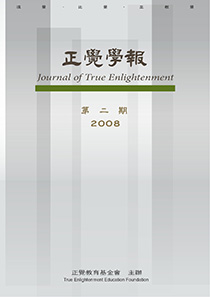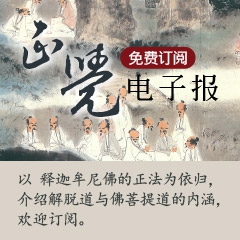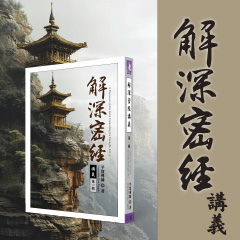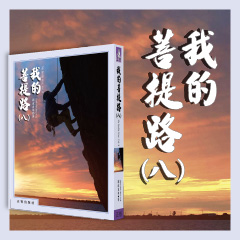Journal of True Enlightenment ─ Issue 2
【作者】正觉学报编辑部
【出版日期】2008年12月
【书号】978-986-83966-2-3
【开本】188页
【定价】300元台币/ 辑
学报宗旨
编辑序言
学报宗旨
正觉学报的宗旨,在于弘扬释迦牟尼佛实证第八识如来藏而成就佛道的佛法义学,秉持学术界客观求真的科学精神,以合乎三量--至教量、现量、比量--的辩证方法,公平客观的引证态度,以及真修实证的立场,引导佛学界回归以实证为目标的佛法义学。
Mission Statement
The mission of the Journal of True Enlightenment is to spread Buddha Sakyamuni's doctrine of attaining Buddhahood through the personal realization of the eighth consciousness, Tathagatagarbha, and to guide the Buddhist academia back to the correct understanding of Buddhist sutras based on the scientific spirit of objectively pursuing the truth, the methodology of the three-ways-of- knowing—knowing by ultimate teachings, personal experience and logical inference, the fair attitude of citation, and the standpoint of both real practice and personal realization.
在探求真理的路上,古今中外之贤圣都是依据事实的观察而实证,并透过严密的论证来演述给众生了知。本学报亦本于此佛法义学求真求实的精神而创刊,并以现代学术论文的方式来发扬佛法正理,揭示现代佛学学术界众多学者一向都忽略的实证精神。除此之外,本学报中所采用的论文皆是依据论藏三量──至教量、现量、比量──的严密方法阐释佛法中深妙义理,而此三量正是引自西方神学体系的现代佛学学术界所缺乏的学术标准。由于近代佛学学术界普遍缺乏论议的标准,往往犹如天马行空一般各自发挥,使得佛学学术论文脱离了追求真理的目标,这是整体佛教教界与学术界的极大损失。因为大量的人力、时间与资源的投入,所获得的结论却常常产生错误,无助于真理的追求、解脱的实证与法界光明的增上,对于世人当然是极大的损失。为了避免这种长期的资源浪费与损失,而且有助于学术界追求真理,以及对传统佛教一向所采用富有实证精神的论藏三量标准,都能精准地修正方向及实际理解,本学报要求所有论文作者都以此标准来造论,确实值得佛教界与学术界的重视。
由于以论藏三量的标准所撰写的论文,才能正确地处理佛学与哲学所面对的所有命题并获致可靠有效的结论,而此结论将具有实证与实践的意义,并非文字训诂式的研究与空谈。因此,以论藏三量为标准的学术论文,可以预见地将会是未来东西方哲学学术界所必然采用的标准与主流。由于现代学术界的训练中缺乏论藏三量的元素,使得要以论藏三量的严谨标准来撰写学术论文,成为高难度的学术创作,也是现代佛学学术界亟待建立的学术能力。在这样的环境条件与标准下,本期学报采用三篇论文:
- 《阿含经》之圣法印略探──兼略论不生不灭法史观(蔡礼政)
- 以《阿含经》略论道德的根源──并略评释昭慧《佛教后设伦理学》(陈介源、蔡礼政)
- 阿赖耶识的内涵与外延──评陈一标〈有关阿赖耶识语义的变迁〉(游冥鸿)
蔡礼政著作的〈《阿含经》之圣法印略探─兼略论不生不灭法史观〉,乃依据富有实证精神之三量标准,探讨《阿含经》中释迦牟尼佛于经中所举示佛法的准绳──圣法印──的意涵,以作为佛学中判断各种学说是非对错的标准。该文探讨释迦牟尼佛所证悟“实相”的内涵与法印之间的关系,进而深入探讨佛教核心教义中“法”有“生灭法”(其异名有:五蕴法、缘起法、缘生法或一切法等等)及“不生不灭法”(其异名有:涅槃、空性、如来藏等等)两大分类的要旨。该文申论生灭法与不生不灭法是法界必然存在的二种法,二者之间有严谨的分类与逻辑关系。如果混淆二种法之间的分类关系而认为彼此可以转换,或者主张只有其中的一种存在,必然会产生严重的逻辑错误。因而此种分类与关系,可以作为论断各式学说主张的准绳,也是构成法印的基本要素。该文将法印的结构分为“根本法印”与“对治法印”以对应不生不灭法与生灭法;并且认为小乘的三法印中,涅槃寂静法印是“根本法印”,即是大乘不生不灭的一实相印而含摄其他生灭的“对治法印”。此项法印的见解在学术界确属创见。
此外,该文辨析及归纳出“释印顺所阐述的佛教史为‘生灭法史观’,并不符合法印的准绳”,因此提出“不生不灭法史观”的独到见解。该文中“法印与史观”的部分,辨析释印顺将印度佛教史切割成三个时期而对应小乘的三法印,有严重的逻辑错误;并证明“不生不灭法史观”才是符合佛教教理的正确史观,并且是以“不生不灭法”作为佛教的核心教义──不论是大乘教或小乘教。此亦是极富学术创见并且符合论藏三量的标准。
陈介源、蔡礼政合著的〈以《阿含经》略论道德的根源──并略评释昭慧《佛教后设伦理学》〉,该文以《阿含经》的义理探讨西方哲学二千余年来,到现代物质文明发展困境下,人类所一直关怀的伦理学的核心命题──道德的根源。该文认为探讨伦理学命题的同时,应该先建立稳固而无法破坏的价值体系。现代伦理学继承二千年来西方哲学对于善、正义、道德受体……等道德用语无法永远明确定义的困境,一直无法对于人类的道德实践有重要的指导意义,就是因为缺乏稳固一致的价值体系。该文认为十法界是佛教所主张永恒且稳固的价值体系,并且以《阿含经》证明:入胎识如来藏是出生与住持十法界的根源,所以也是价值的根源。由于如来藏的真实存在而可以实证,因此使得十法界的价值体系具有实证与实践的意义。这是现代佛教界与学术界的重要创见。
在十法界的价值体系中,六凡业道是所有有情必须面对的业道抉择,四圣法道则是所有有情厌恶业道轮回后,所必须面对的法道抉择。人类每一世的每一事件都在面对业道与法道的抉择,如果没有正确的价值观与抉择的智慧,就无法对伦理学的命题进行探讨与定义。该文认为佛教的义理是主张具有实证意义的“自由意志的抉择智慧”,是在自由意志下以实证的智慧进行实践道德的抉择。该文认为,康德主张基督宗教是理性宗教,却是以不能实证与验证的公设为前提,本质上并不是理性宗教。佛教是以实证三种事实:1、自由意志的抉择,2、如来藏永恒存在,3、法界实相的智慧,在这三者都可以贯彻及亲证的前提下,使得佛教成为真正的理性宗教,因此亦使得自由意志的抉择智慧具有指导道德实践的意义。
此外,该文并因释昭慧《佛教后设伦理学》一书中对于现代伦理学的许多重要命题有所探讨,因此特选该书作为评论的基础。佛教虽然是一个古老的宗教,对于现代伦理学的种种重要命题与道德用语的定义,却仍然能够跨越时间与空间的限制,对于现在物质文明发展下的困境提供发人深醒的智慧,以作为现代人类实践道德的判断准则,因为佛教的义理是宇宙中的真相而不可能被改变。因此,该文认为佛教本质是科学、先进与文明的,同时亦显示佛教一向超越世俗的自由、民主、人权等普世价值,而追求出世间绝对自由──成佛──的最究竟普世价值。由于该文对于伦理学的架构有完整的论述,对于善的定义与道德的根源,亦有独到的创见并切合《阿含经》的义理,且极富深度、广度与高度。该文对于伦理学的研究方法论亦提出极为精辟的主张与创见,因此内容极为精彩丰富,是难得一见的佳作。
游冥鸿所著〈阿赖耶识的内涵与外延──评陈一标〈有关阿赖耶识语义的变迁〉〉,以语意学中内涵与外延的术语,来说明法界实相心──阿赖耶识、第八识、藏识、异熟识、阿陀那识、心、所知依,并申论阿赖耶识的存在乃是一种客观的事实,所以祂有具体的内涵与外延,也能让人观察到祂的存在,因此阿赖耶识乃是客观的存在而有实证的意义。该文以学者陈一标的论文为例,提出大部分的西方和日本学者,将佛教的义理当做思想来研究,这其实是违背佛教经教的基本主张,因为佛教的经教中处处皆留存着要求实证的文字证据。这些学者因为偏见与方法上的错误,所得的结论即成为文字训诂的游戏而不具有效性。
该文以《阿含经》的经文来探讨阿赖耶识内涵,并举证《成唯识论》、《摄大乘论》、《解深密经》所说内涵,作为实证阿赖耶识的外延的重要参考。例如,从阿赖耶识是无始以来的存在,是不待他缘、本然的存在,是诸法的根本因;以许多面向来说明永恒存在的阿赖耶识,其存在条件与方式与其他诸法的存在条件是截然不同的。此外,阿赖耶识隐藏于肉体内,维持众生的寿命,是众生所贪爱的对象,并且被众生内执为我,因此阿赖耶识是具有具体内涵的心体。然而,阿赖耶识一词在语意学中,其实是具有“能藏、所藏与执藏”三种意义,使得不能实证阿赖耶识的古今中外学者,对于阿赖耶识与种子之间的关系是一抑异?只能想像与猜测而产生种种误解。该文对于阿赖耶识的内涵与外延的诠释,有极精辟的创见;并指出阿赖耶识的外延,不是语言文字所能够圆满表述的,因为祂正是语言文字所指涉的真实事物,是实证的标的,只能以实证的方法来认识。阿赖耶识是唯有大乘见道以上的菩萨才能够实证,并且真正了知阿赖耶识的内涵与外延而能够有诠释的能力;故非尚未亲证的阿罗汉所知,更非阿罗汉所能诠释。因此,该文亦是一篇精辟而有创见的佳作。
佛法义学的本质是以实证法界中事实真相的智慧,作为实践道德的依据,使得论文作者、读者、被评论者,皆可以因为追求真理增进法界光明而获得利益。以上三篇论文皆系采用实证精神的三量标准所撰写的论文,由于论证严谨,所以其结论皆具备有效性,可以作为学术界的重要参考,都是难得一见的优秀作品。
Briefing
In the pursuit of truth, the sages and saints since ancient times, around the world, all have their actual realization based on the observation of facts, and expound it to sentient beings through rigorous demonstrations. Based on this truth-seeking spirit of Buddhist practical theory, this Journal is published to propagate the correct theory of Buddha-dharma with modern academic papers, and to demonstrate the positivist spirit that is often neglected by many scholars in modern Buddhist academia. In addition to that, the papers of this Journal all explain the profound Buddhist doctrines based on the rigorous methodology according to the principle of three-valid-cognition-ways for Buddhist treatises, namely valid cognition by ultimate teachings, direct perception and logical inference. The principle of three-valid-cognition-ways is exactly the academic standard that the modern Buddhist academia, which follows the system of Western theology, lacks. Owing to the general lack of argumentation standard in modern Buddhist academia, the researchers often express their views individually in an unrestrained way, which makes the Buddhist academic papers away from the goal of seeking truth; this is a great loss to the whole Buddhist world and academia. Because a large amount of human power, time and resources has been used, and yet the wrong conclusions have often been drawn, without any help in the pursuit of truth, the actual realization of liberation and the greater glory of dharma-realm; it is certainly a great loss to the people of the world. To avoid this long-term waste and loss of resources, and also to help the academia pursue the truth, accurately correct the direction and actually understand the standard of three-valid-cognition-ways for Buddhist treatises (which is full of positivist spirit and is always followed in traditional Buddhism), this Journal requests all the authors to write papers based on this standard and it really deserves special attention from the Buddhist world and academia.
Only those papers that are based on the standard of three-valid-cognition-ways for Buddhist treatises can correctly deal with all the propositions about Buddhism and philosophy and reach reliable valid conclusions; these conclusions will have the significance of actual realization and practice, but not just researches and empty talks like explanatory notes in ancient books. For this reason, the academic papers based on the standard of three-valid-cognition-ways for Buddhist treatises will be foreseeably the standard and the main stream that are definitely followed by the Eastern and Western philosophic academia in the future. Owing to the lack of elements of three-valid-cognition-ways for Buddhist treatises during the training process in modern academia, to write academic papers based on the strict standard of three-valid-cognition-ways for Buddhist treatises becomes a highly difficult task of academic original writing. It is also the academic capability that the modern Buddhist academia urgently needs to build. Under such environmental conditions and standard, three articles are presented in this issue:
- A Brief Exploration on Noble Dharma-Seal in The Agama Sutras──And A Brief Discussion on the Historic View of Neither-Arising-Nor-Ceasing Dharma (Tsai Lichen)
- A Brief Discussion on the Root of Morality Based on The Agama Sutras──And Brief Comment on Shi Zhaohui’s Buddhist Metaethics (Chen Chienyuan, Tsai Lichen)
- The Connotations and Denotations of Alaya Consciousness──Comment on Chen Yibiao’s “About the Changes in the Literal Meaning of Alaya Consciousness” (Yu Minghong)
According to the positivist standard of three-valid-cognition-ways, Tsai Lichen’s article “A Brief Exploration on Noble Dharma-Seal in The Agama Sutras──And A Brief Discussion on the Historic View of Neither-Arising-Nor-Ceasing Dharma” explores the meaning of Noble Dharma-seal, which is the Buddhist standard proposed by Buddha Sakyamuni in The Agama Sutra as the criterion for judging whether various Buddhist theories are correct or not. This article investigates the relationship between the dharma-seal and the connotations of “ultimate reality” realized by Buddha Sakyamuni, and then further deeply into the essential ideas that “dharma” has two main categories in the Buddhist core doctrine: “arising-and- ceasing dharma” (with different names of five-aggregates dharma, dependent-arising dharma, condition-arisen dharma, all dharmas, etc.) and “neither-arising-nor-ceasing dharma” (with different names of nirvana, emptiness-nature, Tathagatagarbha, etc.). This paper explicates that arising-and-ceasing dharma and neither-arising-nor-ceasing dharma are two kinds of dharmas that definitely exist in the dharma-realm; there are strict classification and logic relationship between these two. If the classification and relationship between these two kinds of dharmas are confused and one thinks that they are interchangeable, or proclaims that only one of the two exists, it will makes serious errors in logic. Therefore, this kind of classification and relationship can be used as the standard to judge various theories, and is also the basic element of which dharma-seal is composed. In Tsai’s article, dharma-seal is constructed of “fundamental dharma-seal” and “correction dharma-seal” corresponding to arising-and-ceasing dharma and neither-arising-nor-ceasing dharma respectively; this article also thinks that, in the three Hinayana dharma-seals, the dharma-seal of nirvana being tranquil is “fundamental dharma-seal” and precisely the neither-arising-nor-ceasing Mahayana Seal of One Ultimate Reality, which includes the other arising-and-ceasing “correction dharma- seals.” This view on dharma-seal is indeed an innovative idea in the academic world.
In addition, Tsai’s article analyzes the related documents and concludes that, “the Buddhist history being ‘the historic view of arising-and-ceasing dharma’ expounded by Shi Yinshun is not in accordance with the standard of dharma-seal.” Hence, the author presents the unique “historic view of neither-arising-nor-ceasing dharma.” Concerning the part related to “dharma-seal and the historic view” in this article, the author’s analysis finds that Shi Yinshun’s division of the Buddhist history in India into three periods corresponding respectively to the three Hinayana dharma-seals made serious errors in logic. On the other hand, the author also proves that “the historic view of neither-arising-nor-ceasing dharma” is the correct historic view in accordance with the Buddhist doctrines, and neither-arising- nor-ceasing dharma is taken as the Buddhist core doctrine, whether in the Mahayana or Hinayana teachings. This view is also an innovative idea of great academic value and accords with the standard of three-valid-cognition-ways for Buddhist treatises.
With the practical theory of The Agama Sutras, the article “A Brief Discussion on the Root of Morality Based on The Agama Sutras──And Brief Comment on Shi Zhaohui’s Buddhist Metaethics” (co-authored by Chen Chienyuan and Tsai Lichen) explores the core proposition about ethics in Western philosophy── the root of morality, about which human beings have been concerned for more than two thousand years and even in the difficult development position of modern material civilization. This article thinks that a stable value system which cannot be destroyed should be established first while exploring the propositions about ethics. In modern ethics, the difficult position, in which the moral terms for good, justice, moral patients, etc. in Western philosophy have always been unable to be clearly defined for over two thousand years, still persists; its inability to significantly guide people to the practice of human morality is because it lacks a stable consistent value system. This article thinks that the ten dharma-realms are the eternal and stable value system in Buddhism, and it is proved from The Agama Sutras that the embryo-entering consciousness, Tathagatagarbha, is the origin that gives birth to, dwells in and sustains the ten-dharma-realms, and therefore is the root of value. Owing to the real existence of Tathagatagarbha, which can be actually realized, it gives the value system of ten dharma-realms the significance of actual realization and practice. This is an important innovative idea in modern Buddhist and academic worlds.
In the value system of ten dharma-realms, the six ordinary karma paths of ten dharma-realms are the choice of karma paths faced by all sentient beings; the four noble dharma paths are the choice of dharma paths faced by those who dislike the transmigration (samsara) of karma paths. Human beings are facing the choice of karma paths or dharma paths in every happening of each lifetime. If one does not have the correct value and wisdom to choose, one is unable to explore and define the proposition about ethics. This article thinks that the Buddhist doctrine proposes “the wisdom choice by free will,” which has the significance of actual realization, namely to choose the moral practice with the wisdom of actual realization by free will. This article also thinks that, although Kant claimed Christianity to be a rational religion, yet based on the premise of those postulates which cannot be actually realized or verified, it is intrinsically not a rational religion. In Buddhism, it is to actually realize the three following facts: 1. the choice by free will, 2. the permanent existence of Tathagatagarbha, 3. the wisdom of ultimate reality of dharma-realm; based on the premise that all of the three facts can be thoroughly and personally realized, it makes Buddhism become a real rational religion, and therefore, makes the wisdom choice by free will have the significance of guidance on moral practice.
In addition, Chen’s and Tsai’s article also selects Shi Zhaohui’s book Buddhist Metaethics as a basis for comment, because she explores many important propositions about modern ethics in her book. Although Buddhism is an ancient religion, it still can provide, surpassing the limits of time and space while in this difficult development position of modern material civilization, the inspiring wisdom for various important propositions and definitions of moral terms in modern ethics as the judging standard of moral practice for modern people; it is because the Buddhist doctrines are true reality of the universe and cannot be changed. Hence, this article thinks that Buddhism is intrinsically scientific, advanced and civilized, and at the same time, it also shows that Buddhism always surpasses the universal value of mundane freedom, democracy, human right, etc. to search for the supra-mundane absolute freedom, namely becoming Buddha, which is the ultimate universal value. This article has a complete description and discussion about the structure of modern ethics; concerning the definition of good and the root of morality, a unique innovative idea in accordance with the practical theory of The Agama Sutras is also presented with a great depth, breadth and altitude. This article also proposes a brilliant and innovative view about the research methodology for ethics. Therefore, the content of this article is so wonderful that makes it an excellent piece of writing rarely seen.
Using the semantic terms “connotation” and “denotation,” Yu’s article “The Connotations and Denotations of Alaya Consciousness──Comment on Chen Yibiao’s ‘About the Changes in the Literal Meaning of Alaya Consciousness’” explains the ultimate-reality mind of dharma-realm, which is also called the Alaya consciousness, the eighth consciousness, store consciousness, Vipaka consciousness, Adana consciousness, mind, what the perception depends on, etc., and explicates that the existence of Alaya consciousness is an objective fact; hence it has concrete connotations and denotations and its existence is also observable. For this reason, the Alaya consciousness exists objectively and has the significance of actual realization. Taking Chen Yibiao’s article as an example, this article points out that most Western and Japanese scholars study the Buddhist doctrines by regarding it as a thought. It in fact conflicts with the teachings of Buddhist sutras, because there is lots of recorded evidence in Buddhist sutras about the requirement of actual realization. Those researchers, due to their prejudices and wrong methodology, have drawn invalid conclusions, which are like a game of explanatory words in ancient books.
From the text of The Agama Sutras, this article explores the connotations of Alaya consciousness. The connotations mentioned in The Treatise on Completing the Doctrine of Consciousness-Only, The Collected Mahayana Sastras and Samdhinirmocana Sutra are cited as examples for the important reference to the actual realization of denotations of Alaya consciousness. For example, the Alaya consciousness independently and originally exists since beginningless time and is the root cause of all dharmas. The permanently existing Alaya consciousness is described from many aspects; the conditions and ways of its existence are entirely different from those of other various dharmas. In addition, the Alaya consciousness hides in the physical body and sustains the sentient being’s life; it is the object which each sentient being is greedy for and the self to which each sentient being is internally attached. Hence, the Alaya consciousness is the essence of mind which has concrete connotations. However, the term “Alaya consciousness,” in semantics, actually has three meanings, namely “something that stores things, something where things are stored and something that sustains things.” Concerning the question that the relationship between the Alaya consciousness and seeds is the same one or different ones, those scholars (since ancient time, all around the world) who are unable to actually realize the Alaya consciousness can only imagine and speculate on the answer with various misunderstandings. This article interprets the connotations and denotations of Alaya consciousness with a brilliant and innovative view. The author also points out that the denotations of Alaya consciousness can not be perfectly described through language, because it is the real object which the language refers to and the target for actual realization; only through actual realization can it be recognized. Only those Mahayana bodhisattvas who have seen the Way can actually realize the Alaya consciousness, truly understand the connotations and denotations of Alaya consciousness and can provide the correct interpretation; so it is not understood by those arhats who have not actually realized it, nor can they provide the correct interpretation. Therefore, this article is also an excellent piece of writing with a brilliant and innovative view.
The essence of Buddhist practical theory is to provide the wisdom, which comes from the actual realization of true facts in dharma-realm, as the basis of moral practice; all the authors, readers and the people who have been criticized can benefit from the pursuit of truth to the greater glory of dharma-realm. The three articles above are all written based on the positivist standard of three-valid-cognition-ways. Owing to the strict demonstrations, they have drawn the valid conclusions which can provide important reference for the academic world. All the articles are excellent pieces of writing rarely seen. On behalf of Journal of True Enlightenment, I am grateful to many authors for their earnest contributions and patience for the review by editorial board; I also owe my sincere gratitude to the editors who have reviewed the articles with their best. With the determination to benefit the Buddhist and academic worlds, this Journal is the first to apply the positivist standard of three-valid- cognition-ways to the review of articles. We look forward to the recognition of this standard or any suggestion from the Buddhist and academic worlds. Lastly, it is hoped that the Buddhist and academic worlds all pay their respects to the three-jewels (triratna) because of the benefit in karma paths and dharma paths obtained from the publication of this Journal.








